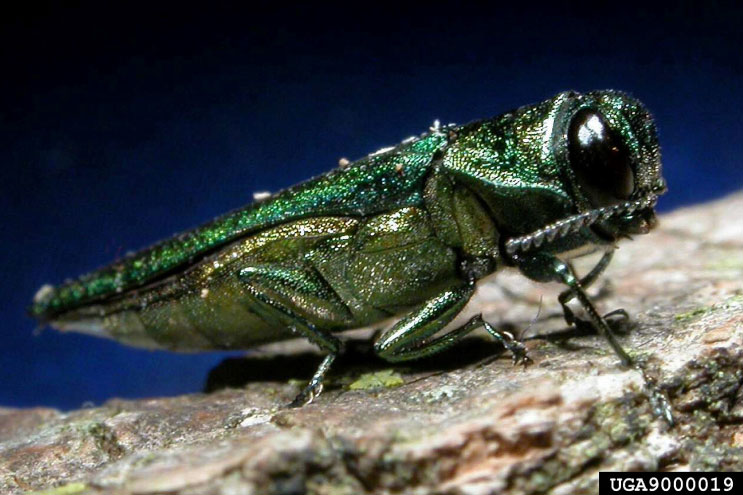EAB – Emerald Ash Borer in Dane County Wisconsin

What is Emerald Ash Borer?
Originally from Asia, the emerald ash borer (EAB) was first discovered in the Detroit area in 2002 and came to Madison in 2013. It is believed to have entered the country on wooden packing materials from China. The bright metallic-green beetle may be smaller than a dime, but it is capable of taking down ash trees thousands of times its size. Adults are typically ½ inch long and ⅛ inch wide. Eggs are extremely small—approximately 1/25 inch—and are reddish-brown in color. Larvae are white, flat-headed borers with distinct segmentation.
Adults usually emerge in mid- to late-May from infestations to the trees during the previous year (earlier if the weather is warm), with females laying their eggs shortly after. The larvae bore into the ash tree and feed under the bark, leaving tracks visible underneath. The feeding disrupts the tree’s ability to transport water and nutrients, resulting in dieback and bark splitting.

What is the threat?
Ash trees are one of the most valuable and abundant North American woodland trees: estimates of total number of ash trees in the United States alone range between seven and nine billion. The emerald ash borer has destroyed 40 million ash trees in Michigan alone and tens of millions throughout other states and Canada. Small trees can die as soon as one to two years after infestation, while larger infested trees can survive for three to four years. Heavy infestations of larval borers speed up the devastation of formerly healthy trees.
Where is it?
The emerald ash borer primarily lives in the midwestern and eastern United States and parts of Canada, but is spreading fast. For Madison and Dane County it has reached an almost 100% coverage our county and will be peaking any year now. Meaning, keep treating your trees or run the risk of having to remove them.

What can you do?
Know the symptoms of EAB: thinning or dying of ash tree crowns, suckers at the base of the tree, splitting bark, tunneling under the bark, D-shaped exit holes and woodpecker activity.
The United States Department of Agriculture (USDA) recommends the following to help manage this pest:
- Call the USDA Emerald Ash Borer Hotline at 1-866-322-4512 or us at 608-838-8522, if you think you’ve found an EAB infestation. We also have more information on our website CapCityTree.com
- Record the area where you found the insect and take photos of the insect along with any damage.
- Don’t move firewood from your property or carry it across state lines.
- Buy firewood from local sources and burn it where you buy it.
- Buy kiln-dried firewood.
- Before spring, burn your remaining firewood supply to eliminate the chance of EAB spreading to live trees.

For more information about possible preventative measures and potential treatments, please contact us or your local certified arborist.









